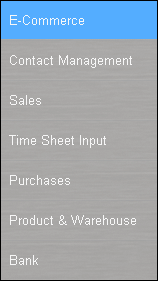Finding your way around the Program
A program that is completely new to you can easily become confusing. The program will contain screens you are not used to working with, and buttons and menus with names and contents you may not recognise. A modern system also contains many different user options, and thus at times, you may need to create many settings.
We are trying our utmost to make the use of functions within the program, as easy as possible for you. However, in order for everyone to get the most out of the program, the functions are able to be customised to match the requirements of an individual user. This applies both to which functions work, and also to how screens, buttons and menus are displayed for each user.
Below is more information about the various elements found in the program screens.
The Main Menu

At the very top of the screen you will find the Main menu. The Main menu covers the upper field of the window, and consists of five different headings: File, Edit, View, Window and Help. You can reach all functions in the program via this menu. It is also this menu that is being referred to throughout the documentation when explaining how to find the various functions. The reason for this is that the Main menu is 'fixed'. Below you can discover how to reach the functions via various shortcuts. Many shortcuts can be edited, making access to those functions you use most often, both quicker and easier.
In the main menu/menu bar at the top of the screen you can activate keyboard shortcuts by pressing [ALT]. You will see an underscore below one letter for each of the menu bar options. This letter is the shortcut key for activating the related menu. Find out more about shortcut keys in Shortcuts in the Program.
The Desktop
By desktop we mean the 'background' in the program, which is constantly displayed behind the various module windows you are opening. The desktop is not the same as the Windows-desktop, where you can find shortcuts to programs, files and other items on your computer.
The desktop will give you an overview of the information flow throughout the various components of the program. It will also give you direct access to status information for every focus area - you define what this information should be. All of this offers you a quick overview and increased control. In addition, the desktop acts as a web browser, giving you access to up-to-date tips, offers, and other user information that can help in your daily work.
It is easy to make adjustments, so that the desktop best fits your way of working.
Focus areas
The focus areas on the left-hand side of the desktop provide quick access to sets of functions that are naturally connected to one another.

For example, when you click on Contact Management in the left-hand menu, the main window to the right will display buttons for the various functions within the module. These are organised according to their relationship to one another and illustrate the process flow within the module. Clicking on the buttons will open the relevant module.
Modules
By Modules we mean a set of functions that are naturally connected to one another. Most of these will be accessible from the View menu as individual choices. An example of a module is all of the functions found under the View - Contacts menu.

Screens in the program
When you open a module, a new screen for the module will also open. The windows in the program are built with the same template for all modules, making it easier for you as a user, to become familiar with the various functions available. There is no need to get your bearings from scratch every time you enter a new window.
A tab is a part of a window. Windows often consist of more information than is possible to present clearly in a single window. Therefore they are often divided with the help of tabs. A tab will always have a name, e.g. the Freight tab within the Sales/Invoicing module. In this tab you are able to view and add information in regards to the freight and delivery of an order.
Read more about: